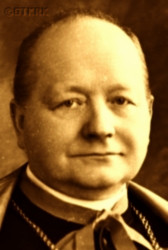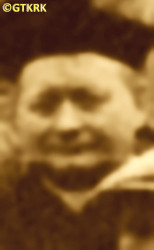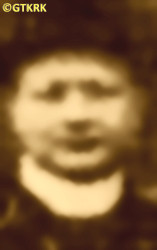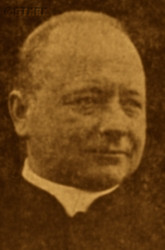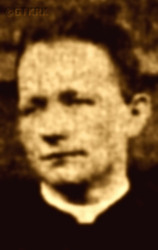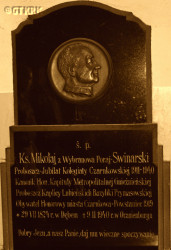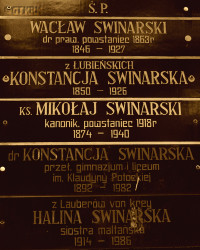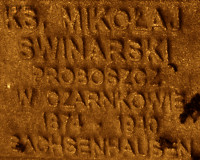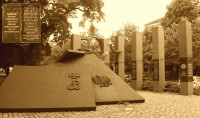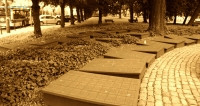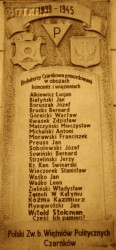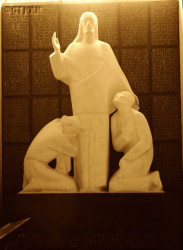Roman Catholic
St Sigismund parish
05-507 Słomczyn
85 Wiślana Str.
Konstancin deanery
Warsaw archdiocese, Poland
full list:
displayClick to display full list

searchClick to search full list by categories
wyświetlKliknij by wyświetlić pełną listę po polsku

szukajKliknij by przeszukać listę wg kategorii po polsku

Martyrology of the clergy — Poland
XX century (1914 – 1989)
personal data
surname
SWINARSKI-PORAJ
forename(s)
Nicholas Ignatius Bogusław (pl. Mikołaj Ignacy Bogusław)
function
diocesan priest
creed
Latin (Roman Catholic) Church RCmore on
en.wikipedia.org
[access: 2014.09.21]
diocese / province
Gniezno and Poznań archdiocese (aeque principaliter)more on
www.archpoznan.pl
[access: 2012.11.23]
RC Military Ordinariate of Polandmore on
en.wikipedia.org
[access: 2014.12.20]
honorary titles
honorary canonmore on
en.wikipedia.org
[access: 2014.11.14]
(1933, Assumption of the Blessed Virgin Mary RC archcathedral church, Gnieznotoday: Gniezno urban gm., Gniezno pov., Greater Poland voiv., Poland
more on
en.wikipedia.org
[access: 2021.12.18])
Gold „Cross of Merit”more on
en.wikipedia.org
[access: 2019.04.16]
(03.12.1938)
date and place
of death
09.02.1940

KL Sachsenhausenconcentration camp
today: Sachsenhausen‐Oranienburg, Oberhavel dist., Brandenburg state, Germany
more on
en.wikipedia.org
[access: 2018.11.18]
details of death
During the Prussian rule in part of portioned Poland, while studying at the Germ. Königliches Gymnasium (Eng. Royal Gymnasium) in Rogoźno, a member of the school group of the Polish clandestine student self‐education organization, the White Eagle Society. From 1888, religious education was taught only in German at the school; from 1889, it was forbidden to read the works of Polish writers, such as A. Mickiewicz, J. Słowacki, Z. Krasiński; from 1890, it was forbidden to give grades in Polish on the secondary school leaving certificate. On c. 1899, the organization was transformed into the „Red Rose” association, and after 1900 into the clandestine Thomas Zan Society.
From 1911 member of the Polish Electoral Committee in the Germ. Kreis Czarnikau (Eng. Czarnków County), in Prussian part of partitioned Poland, i.e. Germ. Provinz Posen (Eng. Province of Poznań), supporting Polish candidates to the Germ. Preußischer Landtag (Eng. Prussian National Parliament) — elections took place in 1913 — and to the Germ. Reichstag (Eng. Reich Parliament) of the German Empire — elections took place in 1912. Spoke, among others, on 01.1912 in Lubasz.
After the abdication on 09.11.1918 of the German Emperor William II Hohenzollern; after the signing on 11.11.1918 by the Allies and the Germans, in the staff wagon in Compiègne, at the headquarters of French Marshal Ferdinand Foch, of the armistice and ceasefire — which de facto meant the end of World War I; and also after the handover on 11.11.1918 by the Regency Council – operating in the so‐called Germ. Königreich Polen (Eng. Polish Kingdom) occupied by the Central Powers (Germany and Austria–Hungary) — of supreme command over the army to Brigadier Joseph Piłsudski and his appointment as Commander‐in‐Chief of the Polish Army, which de facto meant the rebirth of the Polish state, encompassing however only the Germ. Königreich Polen, i.e. the Polish territory under Russian rule until 1915, but excluding the lands of the Prussian partition; Greater Poland — as the Prussian Germ. Provinz Posen (Eng. Poznań Province) — was still formally part of the German state.
His parish Czarnków, the capital of the Germ. Kreis Czarnikau (Eng. Czarnków county), was located in the north of the Germ. Provinz Posen. Both Czarnków and the Germ. Kreis Czarnikau were inhabited by a mixed Polish and German population, with Germans constituting the majority of the county to the north of the Noteć River, which divided it, and Poles in its southern part — Czarnków itself is located on the southern bank of the Noteć. Although several centres were established at that time that described themselves as representative of the local community, initially attempts were made to reach an agreement. And so the Workers' and Soldiers' Council RRŻ, founded on c. 13‐14.11.1918, inspired by and subordinated to a similar council established in Berlin — with the consent of the still partially clandestine Polish Citizens' Committee KO, subordinate to the Central Citizens' Committee CKO from Poznań — consisted of 12 people, 6 Poles and 6 Germans. Both the German mayor of Czarnków and the Germ. landrat (Eng. county administrator) agreed to be subordinate to it. Managed then to push through a resolution on equal rights in public life for the Polish and German languages, and later, on 28.11.1918, to introduce Polish catechesis and reading and writing lessons in Polish in all schools in the Germ. Kreis Czarnikau. On 16.11.1918, became also vice‐chairman of the Executive Department of the County People's Council PRL, founded after the KO started to act in the open, at the appeal of the Supreme People's Council NRL from Poznań, founded after the CKO came out, to represent Polish interests. In response, the Germans established the Germ. Volksrat (Eng. People's Council) and on 23.11.1918, a joint meeting of both people's councils was held, at which a joint — with a majority of Poles — Citizens' Guard was established to maintain order in the city (later transformed into the People's Guard). Managed to force both sides to a joint proclamation in Polish and German, calling for maintaining order and mutual respect for the rights of both nationalities.
The tension between the two sides was growing, however. On 25.11.1918, at the initiative of the Germ. landrat, the German 6th Company of the 148th (or 149th) Infantry Regiment from Piła entered Czarnków and occupied the post office, railway station and district office. This significantly worsened the situation in the city, especially since on 06.12.1918 the commander of the 6th Company demanded the dissolution of the RRŻ, recognising Czarnków as a garrison town in which only representatives of the military should exercise power. The RRŻ protested. The Polish side was divided — some believed that it was necessary to wait for further developments, the others — that it was necessary to start preparing for an uprising. Belonged to the latter group. There are reports that started to gather medical supplies. A „large arsenal purchased with the money of Fr Swinarski” was supposed to be gathered in his rectory.
On 27.12.1918, the Greater Poland Uprising broke out in Poznań. On 03.01.1919, a secret meeting of the PRL, of which was the vice‐chairman, was held. Prob. then, on behalf of the PRL, signed a proclamation calling on the Germ. landrat (Eng. district administrator) to resign and leave for Germany. The nomination of the commander of the armed forces of the western–northern district of the Noteć insurgent units was accepted. The next day, a meeting of the RRŻ was held, at which its chairman, and at the same time a member of the PRL, Stanislav Grupiński, read an alleged telegram from Poznań, which informed about the approach of a 30,000‐strong insurgent army to Czarnków. Nothing of the sort happened, but the RRŻ immediately passed a resolution of no objection to the possible occupation of the city. The German 6th Company, after obtaining a guarantee of safety for the soldiers, surrendered its weapons, left its equipment and left Czarnków. The next day, 05.01.1919, a small insurgent unit and local Polish groups occupied the railway station, the post office and offices, disarmed the Germans policemen and forced the mayor and the Germ. landrat to resign. The Germans, outraged by the ruse, reacted after a few days, on 08.01.1919, when most of the Polish insurgent units had already left Czarnków and headed for the endangered Chodzież, and fighting broke out in the town. Did not leave the rectory supporting the defenders, and in the collegiate church led prayers for freedom. The church was fired at with a machine gun and two grenades, which caused damage to the roof. The Catholic House and the rectory were also damaged. But the city remained in Polish hands.
The Noteć became the de facto border river, separating both sides. And although fighting took place in the area on 02‐13.02.1919, Czarnków remained Polish. This was the situation on 16.02.1919, when an armistice was signed in Trier, enforced by the victorious Entente states, under which the Polish insurgent Greater Poland Army was recognized as an allied army and a border was set, the crossing of which „German troops were forbidden” to cross, leaving a large part of Greater Poland outside their influence. However, it was not until the Treaty of Versailles, concluded on 28.06.1919, that Greater Poland, including Czarnków, was formally awarded to Poland. Officially became part of Poland on 10.01.1920, after the ratification of the treaty by all contracting parties.
The insurgent companies from Czarnków, of which was the chaplain and from which took the oath of allegiance, fought not only in the Greater Poland Uprising, but also — as part of the 9th Greater Poland Rifle Regiment — in the last phases of the Polish–Ukrainian War of 1918‐1919 and the Polish–Russian War of 1919‐1921.
After German invasion of Poland in 09.1939 (Russians invaded Poland 17 days later) and start of the World War II, after start of German occupation, arrested by the Germans on 03.09.1939.
Interned in IL Linde transit camp in Lipka.
In revenge for participation in the Greater Poland Uprising, beaten on every occasion.
Did not break down — on the contrary, comforted other prisoners and stood up for them.
Therefore, his cassock was removed, the harness was taken away and was ordered to stand with his arms up and look straight at the sun.
Beaten when tried to adjust his sagging pants.
One of the soldiers broke his collarbone with a butt.
Nearby, German women were standing and shouting, demanding that the priest be castrated.
From Lipka, at the end of 09.1939, moved to ZL Albatros transit camp in Piła.
Finally, totally exhausted, transported to KL Sachsenhausen concentration camp where perished.
According to the death certificate in the books of the Germ. Standesamt (Eng. registry office) in Oranienburg, No. 886/40, the „honest” otherwise German „medical doctors” and formalists — and at the same time, unrivaled fairy tale spinners — noted that the cause of death was Germ. „Lungenentzündung” (Eng. „Pneumonia”).
prisoner camp's numbers
3726Click to display source page (KL SachsenhausenClick to display the description)
cause of death
extermination: exhaustion and starvation
perpetrators
Germans
sites and events
KL SachsenhausenClick to display the description, ZL AlbatrosClick to display the description, IL LindeClick to display the description, «Intelligenzaktion»Click to display the description, Reichsgau Danzig‐WestpreußenClick to display the description, Ribbentrop‐MolotovClick to display the description, Pius XI's encyclicalsClick to display the description, Greater Poland UprisingClick to display the description, Thomas Zan SocietiesClick to display the description
date and place
of birth
29.07.1874

Dębetoday: Lubasz gm., Czarnków/Trzcianka pov., Greater Poland voiv., Poland
more on
en.wikipedia.org
[access: 2021.12.18]
parents
SWINARSKI Vaclav Nicholas
🞲 1846, ? — 🕆 1927, ?

ŁUBIEŃSKA Constance
🞲 1850, ? — 🕆 1926, ?
presbyter (holy orders)
ordination
13.12.1903

Gnieznotoday: Gniezno urban gm., Gniezno pov., Greater Poland voiv., Poland
more on
en.wikipedia.org
[access: 2021.12.18]
positions held
1911 – 1939
parish priest — Czarnkówtoday: Czarnków gm., Czarnków/Trzcianka pov., Greater Poland voiv., Poland
more on
en.wikipedia.org
[access: 2021.06.20] ⋄ St Mary Magdalene RC parish ⋄ Czarnkówtoday: Czarnków gm., Czarnków/Trzcianka pov., Greater Poland voiv., Poland
more on
en.wikipedia.org
[access: 2021.06.20] RC deanery — also: c. 1922‐1939 deanery notary; c. 1927‐1939 correspondent of the mixed commission for the protection of monuments of art and culture for the Poznań Voivodeship; c. 1929‐1936 county archbishop's delegate at matura exams in teacher seminars; from 1934 church assistant of the Catholic Association of Young Women in the Czarnków county; patron of the local Catholic Society of Polish Workers; 1926‐1928 builder of the church in Kruszewo; member of the County Assembly and its economic commission, responsible for, i.a. the local hospital; president of the local People's Reading Rooms Society TCL; president of the local Charles Marcinkowski Scientific Aid Society in the Czarnków county; president of the Farming Group; member of the board of the Pl. „Rolnik” (Eng „Farmer”) Company; member of the Supervisory Board of the People's Bank
1930 – 1941
chaplain — Gnieznotoday: Gniezno urban gm., Gniezno pov., Greater Poland voiv., Poland
more on
en.wikipedia.org
[access: 2021.12.18] ⋄ RC chapel („Łubieńskis'”) ⋄ Assumption of the Blessed Virgin Mary RC archcathedral church
1909 – 1911
vicar — Poznańtoday: Poznań city pov., Greater Poland voiv., Poland
more on
en.wikipedia.org
[access: 2021.07.18] ⋄ St Martin the Bishop and Confessor RC parish ⋄ Poznańtoday: Poznań city pov., Greater Poland voiv., Poland
more on
en.wikipedia.org
[access: 2021.07.18] RC deanery — also: vice‐patron of the local Catholic Society of Polish Workers; member of the National Union in Poznań, a conservative, landed gentry organization defending Polish national rights in Greater Poland.
1904 – 1909
vicar — PoznańJeżyce neighborhood
today: Poznań city pov., Greater Poland voiv., Poland
more on
en.wikipedia.org
[access: 2021.07.18] ⋄ Sacred Heart of Jesus and St Florian RC parish ⋄ Poznańtoday: Poznań city pov., Greater Poland voiv., Poland
more on
en.wikipedia.org
[access: 2021.07.18] RC deanery — also: president of the „Halka” Singing Society
till 1903
student — Gnieznotoday: Gniezno urban gm., Gniezno pov., Greater Poland voiv., Poland
more on
en.wikipedia.org
[access: 2021.12.18] ⋄ philosophy and theology, Archbishop's Practical Theological Seminary (Lat. Seminarium Clericorum Practicum)
from 1900
student — Poznańtoday: Poznań city pov., Greater Poland voiv., Poland
more on
en.wikipedia.org
[access: 2021.07.18] ⋄ philosophy and theology, Archbishop's Theological Seminary (Collegium Leoninum)
from 1916
membership — Poznańtoday: Poznań city pov., Greater Poland voiv., Poland
more on
en.wikipedia.org
[access: 2021.07.18] ⋄ Friends of Sciences Society
others related
in death
ADAMCZYKClick to display biography Stanislav, BRZĄKAŁAClick to display biography Victor, BURCZYKClick to display biography Felix, BYTOFClick to display biography Peter, CHARSZEWSKIClick to display biography Paulinus Ignatius, CHYLARECKIClick to display biography Stanislav, CIEMNIAKClick to display biography Louis, CYBULSKIClick to display biography Stanislav, CZAKIClick to display biography Saturnin, CZAPIEWSKIClick to display biography Joseph Leonard, DEMSKIClick to display biography Vladislav, DOERINGClick to display biography Alexander, FIGATClick to display biography Henry, GOŃCZClick to display biography Bernard Ambrose, GORALClick to display biography Vladislav, GRZEBIELEWSKIClick to display biography Joseph, GUZClick to display biography Joseph Adalbert (Fr Innocent), HEVELKEClick to display biography Alexander Eugene John Oscar, HINZClick to display biography Francis Felix, HINZClick to display biography Thaddeus, JARZĘBSKIClick to display biography Stanislav Romualdo, JORDANClick to display biography Boleslav, KALINOWSKIClick to display biography Theodore, KARAMUCKIClick to display biography Edmund Leo, KARCZYŃSKIClick to display biography Cyril Methodius, KAŹMIERCZAKClick to display biography Bronislav Anthony, KLEINClick to display biography John Matthias, KOMPFClick to display biography January Sigismund, KONKOLEWSKIClick to display biography Joachim, KOWNACKIClick to display biography Bronislav, KOZUBEKClick to display biography Roman, KRAUZEClick to display biography Edmund, KRUPIŃSKIClick to display biography Louis, KUBIAKClick to display biography John (Bro. Norbert Mary), KUBICKIClick to display biography Steven Adam Marian, KUBISTAClick to display biography Stanislav, KUPILASClick to display biography Francis, LAPISClick to display biography Casimir, LENARTClick to display biography John, LICZNERSKIClick to display biography Constantine John, ŁOSIŃSKIClick to display biography Bernard Anthony, MACIĄTEKClick to display biography Stanislav Paul, MARCHLEWSKIClick to display biography Leonard, MATUSZEWSKIClick to display biography Francis Adam, MĄKOWSKIClick to display biography John, MĘŻNICKIClick to display biography Joseph, MICHNOWSKIClick to display biography Marian John, MITRĘGAClick to display biography Francis, MORKOWSKIClick to display biography Edmund, MOŚCICKIClick to display biography Joseph, NAGÓRSKIClick to display biography Paul Adalbert, NITSCHMANNClick to display biography Adam Robert, NOWAŃSKIClick to display biography Anthony, NOWICKIClick to display biography Alexander, OCHOŃSKIClick to display biography Charles Joseph (Fr Chris), OKOŁO–KUŁAKClick to display biography Anthony, PALUCHOWSKIClick to display biography Boleslav, PETRYKOWSKIClick to display biography Steven, PIASZCZYŃSKIClick to display biography Michael, PODLASZEWSKIClick to display biography Francis, POMIANOWSKIClick to display biography Vladislav, RADTKEClick to display biography Steven Boleslav, SĄSAŁAClick to display biography Theodore, SKOBLEWSKIClick to display biography Mieczyslav, SKOWRONClick to display biography Casimir, SOCHACZEWSKIClick to display biography Bronislav Peter, SYNOWIECClick to display biography Boleslav, SZUKALSKIClick to display biography John Wladysław, SZYMAŃSKIClick to display biography Bruno Peter John, ŚLEDZIŃSKIClick to display biography Joseph Marian, TUSZYŃSKIClick to display biography Joseph, TYMIŃSKIClick to display biography Anthony, WAWRZYNOWICZClick to display biography John, WĄSOWICZClick to display biography Sigismund, WIERZBICKIClick to display biography Sigismund Lawrence, WIERZCHOWSKIClick to display biography Fabian Sebastian, WILLIMSKYClick to display biography Albert, WŁODARCZYKClick to display biography Ignatius, WOHLFEILClick to display biography Robert, WRÓBLEWSKIClick to display biography Bronislav, ZAWISZAClick to display biography Valentine, ZIELIŃSKIClick to display biography Paul Nicholas, ZIEMSKIClick to display biography Alexander Felix, ZIENKOWSKIClick to display biography Vaclav, ŻUCHOWSKIClick to display biography Vaclav
sites and events
descriptions
KL Sachsenhausen: In Germ. Konzentrationslager (Eng. concentration camp) KL Sachsenhausen, set up in the former Olympic village in 07.1936, hundreds of Polish priests were held in 1940, before being transported to KL Dachau. Some of them perished in KL Sachsenhausen. Murderous medical experiments on prisoners were carried out in the camp. In 1942‐1944 c. 140 prisoners slaved at manufacturing false British pounds, passports, visas, stamps and other documents. Other prisoners also had to do slave work, for Heinkel aircraft manufacturer, AEG and Siemens among others. On average c. 50,000 prisoners were held at any time. Altogether more than 200,000 inmates were in jailed in KL Sachsenhausen and its branched, out of which tens of thousands perished. Prior to Russian arrival mass evacuation was ordered by the Germans and c. 80,000 prisoners were marched west in so‐called „death marches” to other camps, i.e. KL Mauthausen‐Gusen and KL Bergen‐Belsen. The camp got liberated on 22.04.1945. After end of armed hostilities Germans set up there secret camp for German prisoners and „suspicious” Russian soldiers. (more on: en.wikipedia.orgClick to attempt to display webpage
[access: 2018.11.18])
ZL Albatros: German transit Germ. Zivilgefangenenlager (Eng. camp for civilians) in Piła, operational in 09‐12.1939, mainly for Polish teachers and religious, who were treated especially rough, before transporting them to KL Sachsenhausen concentration camp, and for Jews. Prisoners were forced to slave in German manufacturing plants and local farms. Altogether more than 500 Poles were held captive there. (more on: pl.wikipedia.orgClick to attempt to display webpage
[access: 2019.11.17])
IL Linde: Germ. „Internierungslager” (Eng. „Internment camp”) — a temporary concentration camp, also described as Germ. „Internierterlager” — established on 01.09.1939, on the day of the German attack on Poland, in Lipka Krajeńska by the German armed forces Wehrmacht. Representatives of all Polish social groups were held there: landowners, teachers, entrepreneurs, priests, railroad workers, farmers, officials. Also military. Also a group of Polish Jews. They all came from the Złotów region (Sępólno Krajeńskie, Tuchola, Wyrzysk, Chojnice, Nakła, Chodzież, Czarnków). At its peak, c. 500 people (mainly men) were held there. Prisoners were beaten (including by thong whips), murders were committed. The degenerate German garrison harassed Catholic clergy. The camp was liquidated prob. in 11/12.1939. (more on: www.77400.plClick to attempt to display webpage
[access: 2024.01.02])
«Intelligenzaktion»: German: «Intelligenzaktion» (English: „Intelligence Action”) — a German program of extermination of the Polish elite, mainly the intelligentsia and leadership layers, carried out from the beginning of the occupation in w 09.1939 to 04.1940, mainly in territories directly annexed to Germany, but also in the so‐called Germ. Generalgouvernement (Eng. General Governorate), where it was called «AB‐aktion». In the first phase, immediately after the beginning of the German occupation, during military operations carried out by the Germ. Wehrmacht (Eng. Armed Forces) and the genocidal units of the Germ. Einsatzgruppen (Eng. Operational Groups) of the Germ. Sicherheitspolizei (Eng. Security Police), i.e. SiPo, and Germ. Sicherheitsdienst des Reichsführers SS (Eng. Security Service of the Reichsführer SS), i.e. SD, organized by the Germ. Reichssicherheitshauptamt (Eng. Reich Main Security Office), i.e. RSHA, which followed the troops, carried out under the Germ. Unternehmen „Tannenberg” (Eng. Operation „Tannenberg”) — based on the so‐called Germ. Sonderfahndungsliste (Eng. Special Wanted Lists), i.e. proscription lists of Poles considered particularly dangerous to the Third Reich, prepared by the Zentralstelle II/P (Polen) unit of the German RSHA. Later, implemented by the German civilian occupation authorities and the genocidal unit of the Germ. Volksdeutscher Selbstschutz (Eng. Ethnic Germans Self‐Defense), whose members were Germ. Volksdeutsche (Eng. Ethnic Germans), i.e. representatives of the German minority in Poland. According to various sources, these lists, at the beginning of 09.1939, could have contained the details of 61,000—88,000 „dangerous” Poles — although these figures cannot be confirmed. In total, during this genocide, c. 50,000 teachers, Catholic priests, representatives of the landed gentry, freelancers, social and political activists, and retired military personnel were systematically and methodically murdered. Another 50,000 were sent to concentration camps, where only a negligible percentage survived. (more on: en.wikipedia.orgClick to attempt to display webpage
[access: 2014.10.04])
Reichsgau Danzig‐Westpreußen: After the Polish defeat in the 09.1939 campaign, which was the result of the Ribbentrop‐Molotov Pact and constituted the first stage of World War II, and the beginning of German occupation in part of Poland (in the other, eastern part of Poland, the Russian occupation began), the Germans divided the occupied Polish territory into five main regions (and a few smaller). The largest one was transformed into Germ. Generalgouvernement (Eng. General Governorate), intended exclusively for Poles and Jews and constituting part of the so‐called Germ. Großdeutschland (Eng. Greater Germany). Two were added to existing German provinces. From two other separate new provinces were created. Vistula Pomerania region was one of them, incorporated into Germany on 08.10.1939, by decree of the German leader Adolf Hitler (formally came into force on 26.10.1939), and on 02.11.1939 transformed into the Germ. Reichsgau Danzig‐Westpreußen (Eng. Reich District of Gdańsk‐West Prussia) province, in which the law of the German state was to apply. The main axis of the policy of the new province, the territory of which the Germans recognized as the Germ. „Ursprünglich Deutsche” (Eng. „natively German”), despite the fact that 85% of its inhabitants were Poles, was Germ. „Entpolonisierung” (Eng. „Depolonisation”), i.e. forced Germanization. C. 60,000 Poles were murdered in 1939‐1940, as part of the Germ. „Intelligenzaktion”, i.e. extermination of Polish intelligentsia and ruling classes, in c. 432 places of mass executions — including c. 220 Polish Catholic priests. The same number were sent to German concentration camps, from where few returned (over 300 priests were arrested, of whom c. 130 died in concentration camps). C. 124,000‐170,000 were displaced, including c. 90,000 to the Germ. Generalgouvernement. Poles were forced en masse to sign the German nationality list, the Germ. Deutsche Volksliste DVL. Polish children could only learn in German. It was forbidden to use the Polish language during Catholic Holy Masses and during confession. Polish landed estates were confiscated..To further reduce the number of the Polish population, Poles were sent to forced labor deep inside Germany. The remaining Poles were treated as low‐skilled labor, isolated from the Germans and strictly controlled — legally, three or three of them could only meet together, even in their own apartments. Many were conscripted into the German Wehrmacht army. After the end of hostilities of World War II, the overseer of this province, the Germ. Reichsstatthalter (Eng. Reich Governor) and the Germ. Gauleiter (Eng. district head) of the German National Socialist Party, Albert Maria Forster, was executed. (more on: en.wikipedia.orgClick to attempt to display webpage
[access: 2024.06.24])
Ribbentrop‐Molotov: Genocidal Russian‐German alliance pact between Russian leader Joseph Stalin and German leader Adolf Hitler signed on 23.08.1939 in Moscow by respective foreign ministers, Mr. Vyacheslav Molotov for Russia and Joachim von Ribbentrop for Germany. The pact sanctioned and was the direct cause of joint Russian and German invasion of Poland and the outbreak of the World War II in 09.1939. In a political sense, the pact was an attempt to restore the status quo ante before 1914, with one exception, namely the „commercial” exchange of the so‐called „Kingdom of Poland”, which in 1914 was part of the Russian Empire, fore Eastern Galicia (today's western Ukraine), in 1914 belonging to the Austro‐Hungarian Empire. Galicia, including Lviv, was to be taken over by the Russians, the „Kingdom of Poland” — under the name of the General Governorate — Germany. The resultant „war was one of the greatest calamities and dramas of humanity in history, for two atheistic and anti‐Christian ideologies — national and international socialism — rejected God and His fifth Decalogue commandment: Thou shall not kill!” (Abp Stanislav Gądecki, 01.09.2019). The decisions taken — backed up by the betrayal of the formal allies of Poland, France and Germany, which on 12.09.1939, at a joint conference in Abbeville, decided not to provide aid to attacked Poland and not to take military action against Germany (a clear breach of treaty obligations with Poland) — were on 28.09.1939 slightly altered and made more precise when a treaty on „German‐Russian boundaries and friendship” was agreed by the same murderous signatories. One of its findings was establishment of spheres of influence in Central and Eastern Europe and in consequence IV partition of Poland. In one of its secret annexes agreed, that: „the Signatories will not tolerate on its respective territories any Polish propaganda that affects the territory of the other Side. On their respective territories they will suppress all such propaganda and inform each other of the measures taken to accomplish it”. The agreements resulted in a series of meeting between two genocidal organization representing both sides — German Gestapo and Russian NKVD when coordination of efforts to exterminate Polish intelligentsia and Polish leading classes (in Germany called «Intelligenzaktion», in Russia took the form of Katyń massacres) where discussed. Resulted in deaths of hundreds of thousands of Polish intelligentsia, including thousands of priests presented here, and tens of millions of ordinary people,. The results of this Russian‐German pact lasted till 1989 and are still in evidence even today. (more on: en.wikipedia.orgClick to attempt to display webpage
[access: 2015.09.30])
Pius XI's encyclicals: Facing the creation of two totalitarian systems in Europe, which seemed to compete with each other, though there were more similarities than contradictions between them, Pope Pius XI issued in 03.1937 (within 5 days) two encyclicals. In the „Mit brennender Sorge” (Eng. „With Burning Concern”) published on 14.03.1938, condemned the national socialism prevailing in Germany. The Pope wrote: „Whoever, following the old Germanic‐pre‐Christian beliefs, puts various impersonal fate in the place of a personal God, denies the wisdom of God and Providence […], whoever exalts earthly values: race or nation, or state, or state system, representatives of state power or other fundamental values of human society, […] and makes them the highest standard of all values, including religious ones, and idolizes them, this one […] is far from true faith in God and from a worldview corresponding to such faith”. On 19.03.1937, published „Divini Redemptoris” (Eng. „Divine Redeemer”), in which criticized Russian communism, dialectical materialism and the class struggle theory. The Pope wrote: „Communism deprives man of freedom, and therefore the spiritual basis of all life norms. It deprives the human person of all his dignity and any moral support with which he could resist the onslaught of blind passions […] This is the new gospel that Bolshevik and godless communism preaches as a message of salvation and redemption of humanity”… Pius XI demanded that the established human law be subjected to the natural law of God , recommended the implementation of the ideal of a Christian state and society, and called on Catholics to resist. Two years later, National Socialist Germany and Communist Russia came together and started World War II. (more on: www.vatican.vaClick to attempt to display webpage
[access: 2023.05.28], www.vatican.vaClick to attempt to display webpage
[access: 2023.05.28])
Greater Poland Uprising: Military insurrection of Poles of former German Germ. Posen Provinz (Eng. Poznań province) launched against German Reich in 1918‐1919 — after the abdication on 09.11.1918 of the German Emperor William II Hohenzollern; after the armistice between the Allies and Germany signed on 11.1.1918 in the HQ wagon in Compiègne, the headquarters of Marshal of France Ferdinand Foch — which de facto meant the end of World War I — against the German Weimar Republic, established on the ruins of the German Empire, aiming to incorporate lands captured by Prussia during partitions of Poland in XVIII century into Poland. The Republic of Poland, reborn on 11.11.1918, initially formally included only the so‐called Germ. Königreich Polen (Eng. Kingdom of Poland), i.e. the territory that had been under Russian rule until 1915 and then under the control of Central States (Germany and Austria–Hungary), but did not include the Prussian partition. Started on 27.12.1918 in Poznań and ended on 16.02.1919 with the armistice pact in Trier, forced by the victorious Entente states, which included provisions ordering Germany to cease operations against Poland and, importantly, recognizing the Polish insurgent Greater Poland Army as an allied armed force of the Entente. De facto it turned out to be a Polish victory, confirmed in the main peace treaty after World War I, the Treaty of Versailles of 28.06.1919, which came into force on 10.01.1920 and in which most of the lands of the Prussian partition were recognized as Polish. Many Polish priests took part in the Uprising, both as chaplains of the insurgents units and members and leaders of the Polish agencies and councils set up in the areas covered by the Uprising. In 1939 after German invasion of Poland and start of the World War II those priests were particularly persecuted by the Germans and majority of them were murdered. (more on: en.wikipedia.orgClick to attempt to display webpage
[access: 2016.08.14])
Thomas Zan Societies: Secret societies of Polish youth, aiming at self‐education, patriotic in form and content, functioning 1830‐1920, in mutiny against enforced Germanisation and censure of Polish culture, mainly in secondary schools — gymnasia — mainly in Greater Poland (Wielkopolska) and later in Silesia. The first groups were formed in 1817. In 1897 a congress in Bydgoszcz was held when rules of clandestine activities were formulated. At other congress in Bydgoszcz in Poznań a „Red Rose” society was formed, heading all others groups in various gymnasiums and coordinating their activities. In 1900 „Red Rose” consolidated Philomaths organizations from Pomerania as well. After Toruń trial of Pomeranian Philomaths in Toruń Germans arrested 24 members of Thomas Zan Society from Gniezno. 21 of them were sentenced up to 6 weeks in prison and reprimands. All were relegated from schools without the right to continue education in secondary and higher schools in Prussia. Despite repression the Societies existed till 1918 and rebirth of Poland. (more on: pl.wikipedia.orgClick to attempt to display webpage
[access: 2021.12.19])
sources
personal:
www.wtg-gniazdo.orgClick to attempt to display webpage
[access: 2012.11.23], polacywberlinie.plClick to attempt to display webpage
[access: 2013.05.19], ecclesiazdziejowwielkopolski.amu.edu.plClick to attempt to display webpage
[access: 2013.12.04]
bibliographical:
„Social Activist Priests in Greater Poland”, collective work, Biographical Dictionary, vol. 3 P‐S, Gniezno 2008
„International Tracing Service (ITS), Bad Arolsen, GermanyClick to display source page”, Arolsen Archives
original images:
www.wtg-gniazdo.orgClick to attempt to display webpage
[access: 2012.11.23], www.czarnkow.infoClick to attempt to display webpage
[access: 2024.12.13], mck.czarnkow.plClick to attempt to display webpage
[access: 2024.12.13], www.bikop.euClick to attempt to display webpage
[access: 2016.08.14], www.wtg-gniazdo.orgClick to attempt to display webpage
[access: 2012.11.23], www.wtg-gniazdo.orgClick to attempt to display webpage
[access: 2012.11.23], www.wtg-gniazdo.orgClick to attempt to display webpage
[access: 2012.11.23], mpn.poznan.uw.gov.plClick to attempt to display webpage
[access: 2016.03.14]
LETTER to CUSTODIAN/ADMINISTRATOR
If you have an Email client on your communicator/computer — such as Mozilla Thunderbird, Windows Mail or Microsoft Outlook, described at WikipediaPatrz:
en.wikipedia.org, among others — try the link below, please:
LETTER to CUSTODIAN/ADMINISTRATORClick and try to call your own Email client
If however you do not run such a client or the above link is not active please send an email to the Custodian/Administrator using your account — in your customary email/correspondence engine — at the following address:

giving the following as the subject:
MARTYROLOGY: SWINARSKI-PORAJ Nicholas Ignatius
To return to the biography press below:
 Click to return to biography
Click to return to biography








